错误分析
错误原因分析报告范文(精选)(一)2024

错误原因分析报告范文(精选)(一)【引言概述】错误原因分析是在工作中常见的一项任务,通过对错误的原因进行深入剖析,可以为工作提供改进的方向和解决的思路。
本文将针对错误原因分析进行详细的讨论,包括五大点的内容:A、B、C、D、E。
【正文】【A】错误原因分析点一1. 小点一:错误日志的收集和分析2. 小点二:系统环境的调查与验证3. 小点三:关键操作的跟踪与回放4. 小点四:数据的监控与记录5. 小点五:协作团队的问题讨论和分析【B】错误原因分析点二1. 小点一:代码的审查和调试2. 小点二:引入代码测试工具3. 小点三:日志加入调试信息4. 小点四:异常处理和报告机制5. 小点五:与开发团队合作解决问题【C】错误原因分析点三1. 小点一:问题现象的详细描述2. 小点二:历史数据分析和对比3. 小点三:用户操作步骤重现4. 小点四:环境配置和参数调整5. 小点五:现场问题调查和沟通记录【D】错误原因分析点四1. 小点一:技术文档和知识库查询2. 小点二:解决方案和技巧分享3. 小点三:针对特定问题进行培训4. 小点四:问题定期总结与分析5. 小点五:其他资源的利用和整合【E】错误原因分析点五1. 小点一:问题影响度的评估2. 小点二:解决需要的时间与资源3. 小点三:解决方案的有效性分析4. 小点四:风险评估与管控5. 小点五:问题解决的持续跟踪与改进【总结】错误原因分析是一个复杂而关键的工作,通过合理的分析方法和有效的解决方案,可以帮助团队更好地应对问题和提高工作效率。
在进行错误原因分析时,我们需要注意收集、分析和验证数据的准确性,同时要保持与团队的良好沟通和协作,以达到问题解决的最佳效果。
《错误分析理论》课件

字形和书写
汉字的繁体和简体、笔画的顺序 和书写方式常常引发学习者的困 惑。
语用和交际
汉语的交际方式和言语习惯与学 习者的母语差异较大,容易产生 错误。
错误分析的意义和局限性
错误分析理论有其独特的意义,同时也存在不足之处。本节将对错误分析理论的意义和局限性进行详细阐述。
意义
通过错误分析,可以加深对学习者语言能力水 平、学习特点和价值观的了解,有利于指导教 学。
错误分析包括错误的分类、错误 的原因分析和错误的修正方法。
相关概念
错误分析理论与二语习得、教学 法、评估等相关领域密切相关。
错误分析的原理和方法
本节将主要介绍错误分析的原理和方法,帮助你全面掌握错误分析的实践技能。
原理
错误分析理论认为,语言学习者产生错误并不 是一种无意义的行为,而是一种表达学习者语 言能力的方式。
方法
错误分析的具体方法包括错误分类、错误的原 因分析和错误的修正。需要针对不同的错误类 型进行分析和解决。
错误分析在语言学习中的应用
本节将从实践角度介绍错误分析在语言学习中的应用,帮助你了解如何将错误分析理论有效地应用到语 言学习实践中。
1
指导教学
通过错误分析,教师可以了解学生的语言能力,从而更有针对性地指导学生进行学习。
学习者
教师
研究者
《错误分析理论》PPT课 件
本课件将详细地介绍错误分析理论的概念、原则和应用,帮助你了解错误分 析在语言学习中的意义和局限性。
错误分析理论简介
错误分析指的是对学习者的错误语言进行分析,并尝试寻找错误产生的原因和解决方法。本节将介绍错误分析 理论的发展史以及主要概念。
历史沿革
主要概念
从20世纪60年代开始,错误分析 作为一种教学方法逐渐受到重视。
错误分析的技巧
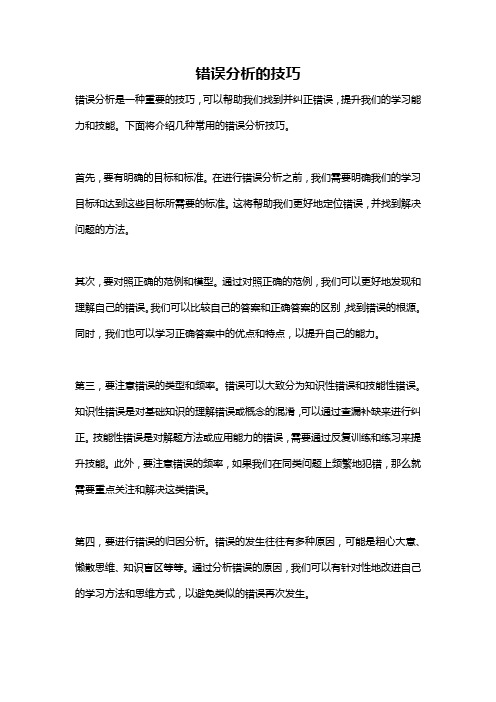
错误分析的技巧错误分析是一种重要的技巧,可以帮助我们找到并纠正错误,提升我们的学习能力和技能。
下面将介绍几种常用的错误分析技巧。
首先,要有明确的目标和标准。
在进行错误分析之前,我们需要明确我们的学习目标和达到这些目标所需要的标准。
这将帮助我们更好地定位错误,并找到解决问题的方法。
其次,要对照正确的范例和模型。
通过对照正确的范例,我们可以更好地发现和理解自己的错误。
我们可以比较自己的答案和正确答案的区别,找到错误的根源。
同时,我们也可以学习正确答案中的优点和特点,以提升自己的能力。
第三,要注意错误的类型和频率。
错误可以大致分为知识性错误和技能性错误。
知识性错误是对基础知识的理解错误或概念的混淆,可以通过查漏补缺来进行纠正。
技能性错误是对解题方法或应用能力的错误,需要通过反复训练和练习来提升技能。
此外,要注意错误的频率,如果我们在同类问题上频繁地犯错,那么就需要重点关注和解决这类错误。
第四,要进行错误的归因分析。
错误的发生往往有多种原因,可能是粗心大意、懒散思维、知识盲区等等。
通过分析错误的原因,我们可以有针对性地改进自己的学习方法和思维方式,以避免类似的错误再次发生。
第五,要积极请教他人的意见和建议。
在错误分析的过程中,我们可以向他人请教,寻求他们的意见和建议。
他们可能会从不同的角度和经验中给予我们帮助和指导,帮助我们更好地理解和纠正自己的错误。
最后,要进行反馈和再次练习。
错误分析是一个循环的过程,我们需要将错误的分析结果反馈到我们的学习中,不断地修正和改进。
同时,我们也需要不断地进行练习和巩固,以加深对知识和技能的理解和运用。
总之,错误分析是提升学习能力和技能的关键技巧之一。
通过明确目标和标准、对照范例和模型、注意错误的类型和频率、进行归因分析、请教他人的意见和建议、进行反馈和再次练习等,我们可以更好地找到并纠正错误,提高我们的学习效果。
错误案例分析万能模板范文

错误案例分析万能模板范文一、案例引入。
咱今儿个来分析个超有趣(也可能超让人头疼)的错误案例。
就说这么个事儿啊,[简要描述案例内容,比如小明在做数学作业的时候,本来是很简单的加法题,结果却错得一塌糊涂]。
这就像是本来要去东边,结果一脚油门踩向了西边,完全偏离了正确的轨道,你说奇不奇怪?二、错误表象分析。
1. 表面现象一。
首先呢,从表面上看,就像我们刚刚说的小明做数学题。
他的答案那是和正确答案相差十万八千里。
[具体指出错误的表现,例如把3 + 5算成了10]这就好比做菜的时候,人家菜谱上写着放一勺盐,他却放了半碗,味道能对才怪呢。
2. 表面现象二。
再看看啊,他写的解题步骤也是乱七八糟的。
[详细描述解题步骤中的错误之处,像是步骤跳跃或者使用了错误的公式]这就跟搭积木一样,本来应该一块一块按照顺序搭,他倒好,从中间抽了几块,然后又乱插,最后搭出来的东西根本不是个样子。
三、错误原因探究。
1. 知识层面。
咱先从知识这个根子上找原因。
很可能啊,小明对加法的基本概念就没掌握好。
他可能就没搞清楚数字相加是个啥意思,就像你要去一个地方,但是你根本不知道路该怎么走。
也许他在学加法的时候开小差了,脑子里想着小飞机,没听老师讲1 + 1到底等于几。
2. 态度层面。
这态度也是个大问题啊。
你看他写作业的时候,那字迹潦草得像鬼画符一样。
这说明他可能就没有认真对待这个作业。
就好像你要去参加一场很重要的比赛,但是你却穿着拖鞋,吊儿郎当的,能赢才怪呢。
他可能觉得这只是个小作业,随便做做就行,完全没有意识到每个小错误都可能在以后变成大麻烦。
3. 习惯层面。
从习惯方面来说,小明可能没有检查作业的习惯。
做完了就扔在一边,就像厨师做完菜不尝尝味道就端上桌。
要是他能稍微检查一下,说不定就能发现自己把3 + 5算成10这个低级错误了。
这种不检查的习惯就像是在黑暗里走路,很容易就掉进坑里。
四、错误影响分析。
1. 短期影响。
在短期呢,这个错误直接导致他作业得了个很低的分数。
错误案例分析万能模板范文

错误案例分析万能模板范文一、案例引入。
咱今儿个来唠唠这么个事儿。
就说[具体场景或者事件主角]发生了[具体事件]这档子事儿,你乍一听可能觉得没啥大不了的,可这里面的错误啊,就像藏在蛋糕里的小石子儿,不仔细品品还真发现不了,但一旦发现了,那可就有点硌牙喽。
二、错误呈现。
1. 错误一:明显的失误。
首先呢,这事儿里最扎眼的错误就是[指出第一个错误]。
这就好比你要去参加一场赛跑,结果你跑错了方向,朝着反方向猛冲。
你说这不是白费劲嘛!就像[举一个类似的简单易懂的例子],本来是要赚钱的买卖,结果因为这个错误,把成本都搭进去了,还没赚到一分钱。
2. 错误二:深层次的问题。
还有啊,在这事儿背后,还藏着一个更深层次的错误,那就是[阐述第二个错误]。
这就像房子的地基没打好,表面上看着房子盖得还挺漂亮,可稍微来点风雨,就得摇摇欲坠。
比如说[相关例子],只注重了表面的东西,没顾得上内里的根基,最后整个事情就变得像个纸糊的老虎,一捅就破。
三、错误原因分析。
1. 主观原因。
咱先说说主观上的原因哈。
这里面的人啊,可能是[分析人的想法或者态度导致的错误]。
就像是一个人太自负了,觉得自己啥都懂,不把别人的建议当回事儿。
这就好比是闭着眼睛走路,还觉得自己能走到目的地呢,不摔跟头才怪。
或者呢,是因为[提到另一种可能的主观因素],像粗心大意。
这就跟你出门老是忘带钥匙似的,虽然是个小毛病,但有时候就能引出大麻烦。
在这个案例里,就是因为这么一丢丢的粗心,整个事情就被搞砸了。
2. 客观原因。
再看看客观方面的因素。
当时的[描述客观环境或者条件]可能也对这个错误起到了推波助澜的作用。
比如说啊,时间太紧了,就像你只有五分钟要做一顿满汉全席一样,那肯定是手忙脚乱,容易出错。
又或者是资源不够,就像你要盖高楼大厦,却只有几块砖头,这怎么能行呢?四、错误造成的影响。
1. 短期影响。
这个错误在短期内那影响可不小啊。
直接就导致了[阐述短期的负面结果],就像是一场暴风雨突然来袭,把刚种好的小树苗都给吹歪了。
错误原因分析报告范文
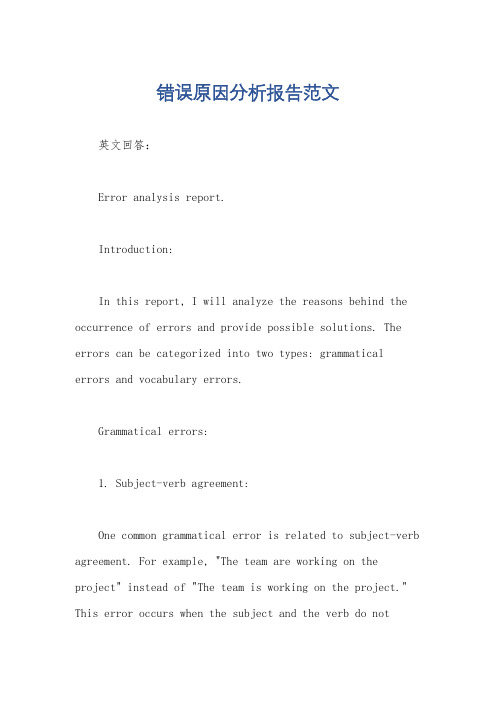
错误原因分析报告范文英文回答:Error analysis report.Introduction:In this report, I will analyze the reasons behind the occurrence of errors and provide possible solutions. The errors can be categorized into two types: grammaticalerrors and vocabulary errors.Grammatical errors:1. Subject-verb agreement:One common grammatical error is related to subject-verb agreement. For example, "The team are working on the project" instead of "The team is working on the project." This error occurs when the subject and the verb do notagree in number. To avoid this error, it is important to ensure that the subject and the verb match in terms of singular or plural form.2. Verb tense:Another frequent grammatical error is related to verb tense. For instance, saying "I have seen that movie yesterday" instead of "I saw that movie yesterday." This error occurs when the wrong tense is used to describe a past event. To avoid this error, it is crucial to use the correct past tense form when referring to a specific time in the past.Vocabulary errors:1. Word choice:One common vocabulary error is related to word choice. For example, saying "I am very exciting about the trip" instead of "I am very excited about the trip." This error occurs when the wrong word is used to express a certainfeeling or emotion. To avoid this error, it is important to choose the appropriate word that accurately conveys the intended meaning.2. Idioms and phrasal verbs:Another frequent vocabulary error is related to idioms and phrasal verbs. For instance, saying "I will call you back in a minute" instead of "I will get back to you in a minute." This error occurs when the wrong idiom or phrasal verb is used in a certain context. To avoid this error, it is essential to learn and understand the correct usage of idioms and phrasal verbs.Conclusion:In conclusion, the errors analyzed in this report are primarily grammatical errors and vocabulary errors. These errors can be avoided by paying attention to subject-verb agreement, verb tense, word choice, and idioms/phrasal verbs. By being mindful of these aspects and practicing their correct usage, one can improve their language skillsand reduce the occurrence of errors.中文回答:错误原因分析报告。
错误分析报告
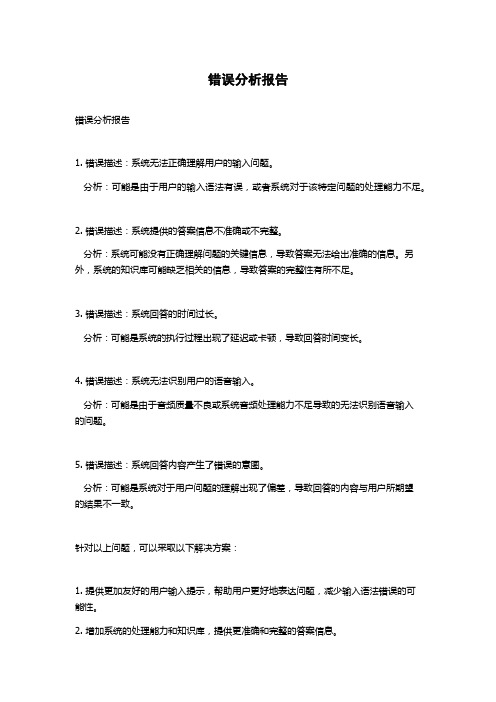
错误分析报告
错误分析报告
1. 错误描述:系统无法正确理解用户的输入问题。
分析:可能是由于用户的输入语法有误,或者系统对于该特定问题的处理能力不足。
2. 错误描述:系统提供的答案信息不准确或不完整。
分析:系统可能没有正确理解问题的关键信息,导致答案无法给出准确的信息。
另外,系统的知识库可能缺乏相关的信息,导致答案的完整性有所不足。
3. 错误描述:系统回答的时间过长。
分析:可能是系统的执行过程出现了延迟或卡顿,导致回答时间变长。
4. 错误描述:系统无法识别用户的语音输入。
分析:可能是由于音频质量不良或系统音频处理能力不足导致的无法识别语音输入
的问题。
5. 错误描述:系统回答内容产生了错误的意图。
分析:可能是系统对于用户问题的理解出现了偏差,导致回答的内容与用户所期望
的结果不一致。
针对以上问题,可以采取以下解决方案:
1. 提供更加友好的用户输入提示,帮助用户更好地表达问题,减少输入语法错误的可
能性。
2. 增加系统的处理能力和知识库,提供更准确和完整的答案信息。
3. 优化系统执行过程,提高回答速度,减少用户等待时间。
4. 改进语音识别技术,提高对语音输入的准确性和识别率。
5. 加强对用户问题的理解和意图识别,确保回答的内容与用户期望一致。
通过以上改进措施,可以提高系统的性能和准确性,提供更好的用户体验。
错误原因分析报告
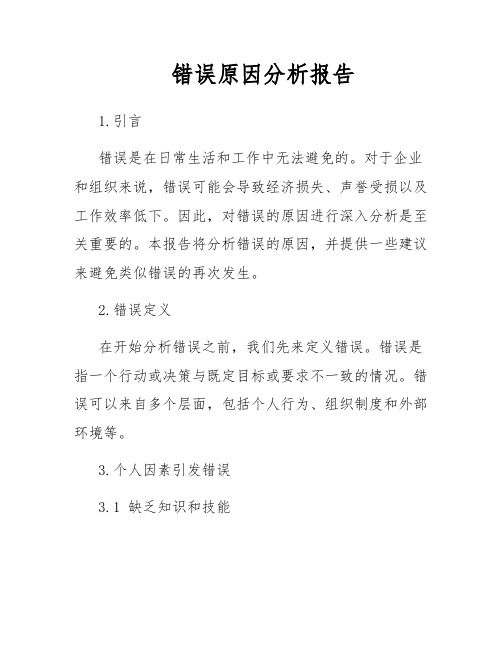
错误原因分析报告1.引言错误是在日常生活和工作中无法避免的。
对于企业和组织来说,错误可能会导致经济损失、声誉受损以及工作效率低下。
因此,对错误的原因进行深入分析是至关重要的。
本报告将分析错误的原因,并提供一些建议来避免类似错误的再次发生。
2.错误定义在开始分析错误之前,我们先来定义错误。
错误是指一个行动或决策与既定目标或要求不一致的情况。
错误可以来自多个层面,包括个人行为、组织制度和外部环境等。
3.个人因素引发错误3.1 缺乏知识和技能一个人如果缺乏必要的知识和技能,很容易在工作中犯错。
例如,一位不懂得使用计算机软件的员工可能会在进行数据分析时出现错误。
3.2 注意力不集中注意力不集中是另一个常见的个人因素,导致错误的发生。
当一个人分心或被其他事物干扰时,他可能会犯错误。
例如,一位在开会时心不在焉的员工可能会错过一些关键信息。
3.3 心理状态不稳定心理状态不稳定也可能会导致错误。
例如,一个身心疲惫的员工可能无法集中精力完成任务,从而导致错误的发生。
4.组织因素引发错误4.1 人际关系问题人际关系问题是组织中常见的问题之一,可能会引发错误。
例如,团队成员之间的不和谐关系可能导致信息共享不足或交流不畅,从而导致错误的发生。
4.2 不合适的流程和制度如果组织的流程和制度不合适,可能会增加错误发生的概率。
例如,一个流程复杂且缺乏透明度的组织可能导致信息丢失或误解,从而引发错误。
4.3 资源不足资源不足也是一个常见的组织因素,可能导致错误的发生。
例如,一个没有足够人员和设备的部门可能无法及时完成工作,从而引发错误。
5.外部环境因素引发错误5.1 经济环境经济环境的变化可能会引发错误。
例如,当经济衰退时,企业可能会面临收入下降和成本增加的压力,从而导致错误的发生。
5.2 法规和政策变化法规和政策的变化也可能会引发错误。
例如,一个企业如果没有及时了解并适应新的法规要求,可能会在业务运营中犯错误。
5.3 自然灾害自然灾害是一个无法控制的外部因素,但它也可能会引发错误。
错误分析范文

错误分析范文开头段落:在学习和工作中,我们难免都会犯错误。
正确处理错误,从错误中吸取教训,是成功的重要一环。
本文将以一次实验任务中的错误为例,进行错误原因分析,总结经验教训。
问题描述:上个月,我们小组进行了一次新型材料的是一个错误分析范文的:错误分析范文一、错误的发生本次试验过程中,出现了以下错误:1. 在6月15日下午3点对样品进行加热时,温度控制器显示的实际温度低于设定温度,导致样品没有达到设定的150°温度。
2. 6月16日上午10点从分光计读取数据时,仪器显示"错误代码45",导致该次数据读取失败。
3. 6月17日下午进行样品检测时,探头脱离样品液,读取到的值非常偏离实际值。
二、错误原因分析1. 温度控制器误差导致实际温度低于设定温度:通过与制造商联系,了解到该批次温度控制器存在±5°的标准误差。
此次出现的差异在误差范围内。
2. 仪器错误代码45通常由探头连接松脱或信号线插座问题引起:经排查,发现该次数据读取前信号线即插得不紧。
3. 探头脱离样品直接暴露在空气中读数,导致错误的读数。
三、改进措施1. 提前了解新设备的技术参数,掌握合理的误差范围防止主观臆断。
2. 检查与验证探头和信号线的良好连接,尤其是数据读取前。
3. 加强样品检测操作规范,训练人员注意细节防止仪器脱位。
四、经验总结通过此次错误分析,我们应该注意以下重点:1. 彻底了解设备本身特性,避免因为主观因素影响判断。
2. 注重人工操作细节,加强检查验证与训练以降低因人为错误概率。
3. 及时整改并记录解决办法,以供后续工作参考。
这篇范文分析了错误的发生、原因分析、改进措施和经验总结等内容,帮助理解如何进行科学的错误分析。
当然,还需要根据实际情况配合修改调整。
检讨书的错误原因分析和问题解决思路
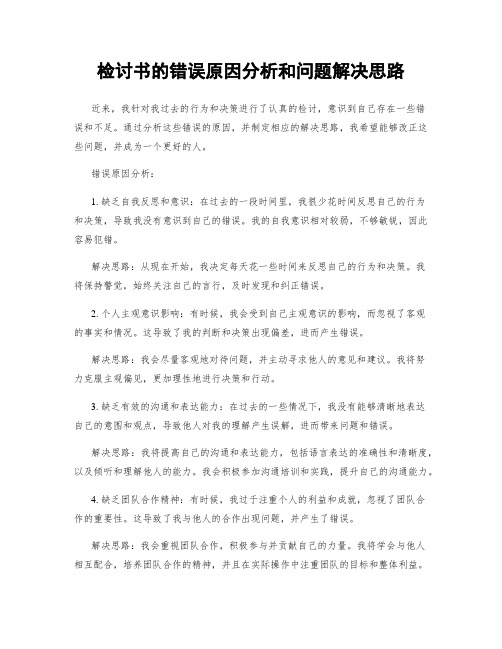
检讨书的错误原因分析和问题解决思路近来,我针对我过去的行为和决策进行了认真的检讨,意识到自己存在一些错误和不足。
通过分析这些错误的原因,并制定相应的解决思路,我希望能够改正这些问题,并成为一个更好的人。
错误原因分析:1. 缺乏自我反思和意识:在过去的一段时间里,我很少花时间反思自己的行为和决策,导致我没有意识到自己的错误。
我的自我意识相对较弱,不够敏锐,因此容易犯错。
解决思路:从现在开始,我决定每天花一些时间来反思自己的行为和决策。
我将保持警觉,始终关注自己的言行,及时发现和纠正错误。
2. 个人主观意识影响:有时候,我会受到自己主观意识的影响,而忽视了客观的事实和情况。
这导致了我的判断和决策出现偏差,进而产生错误。
解决思路:我会尽量客观地对待问题,并主动寻求他人的意见和建议。
我将努力克服主观偏见,更加理性地进行决策和行动。
3. 缺乏有效的沟通和表达能力:在过去的一些情况下,我没有能够清晰地表达自己的意图和观点,导致他人对我的理解产生误解,进而带来问题和错误。
解决思路:我将提高自己的沟通和表达能力,包括语言表达的准确性和清晰度,以及倾听和理解他人的能力。
我会积极参加沟通培训和实践,提升自己的沟通能力。
4. 缺乏团队合作精神:有时候,我过于注重个人的利益和成就,忽视了团队合作的重要性。
这导致了我与他人的合作出现问题,并产生了错误。
解决思路:我会重视团队合作,积极参与并贡献自己的力量。
我将学会与他人相互配合,培养团队合作的精神,并且在实际操作中注重团队的目标和整体利益。
问题解决思路:1. 强化自我反思和意识:通过每天的自我反思和意识训练,我将逐渐提高自我意识的敏锐度,及时发现自己的错误并加以解决。
2. 培养客观的思维方式:我会多角度思考问题,并尽量收集更多的信息和意见,以避免个人主观意识的影响。
同时,我也会注意对他人的意见保持开放态度,并以客观的角度进行分析和判断。
3. 提高沟通和表达能力:我会通过学习和实践来提高自己的沟通和表达能力,包括提升语言表达的准确性和清晰度,以及倾听和理解他人的能力。
错误原因分析报告范文(必备(一)
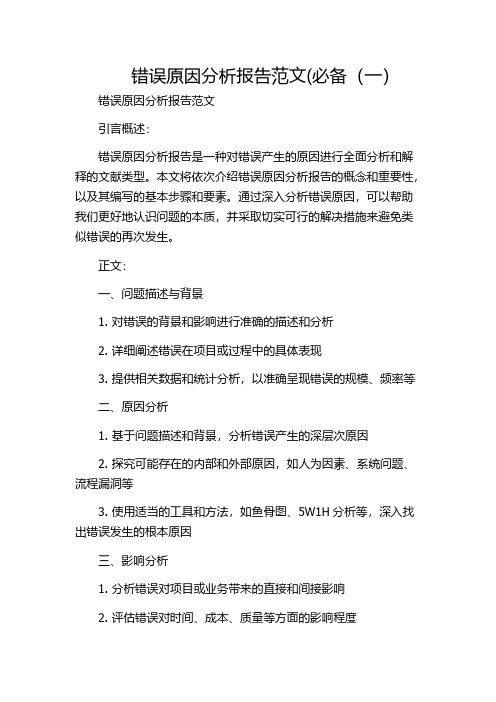
错误原因分析报告范文(必备(一)错误原因分析报告范文引言概述:错误原因分析报告是一种对错误产生的原因进行全面分析和解释的文献类型。
本文将依次介绍错误原因分析报告的概念和重要性,以及其编写的基本步骤和要素。
通过深入分析错误原因,可以帮助我们更好地认识问题的本质,并采取切实可行的解决措施来避免类似错误的再次发生。
正文:一、问题描述与背景1. 对错误的背景和影响进行准确的描述和分析2. 详细阐述错误在项目或过程中的具体表现3. 提供相关数据和统计分析,以准确呈现错误的规模、频率等二、原因分析1. 基于问题描述和背景,分析错误产生的深层次原因2. 探究可能存在的内部和外部原因,如人为因素、系统问题、流程漏洞等3. 使用适当的工具和方法,如鱼骨图、5W1H分析等,深入找出错误发生的根本原因三、影响分析1. 分析错误对项目或业务带来的直接和间接影响2. 评估错误对时间、成本、质量等方面的影响程度3. 探讨错误对公司形象、客户满意度等方面的长期影响四、解决方案与改进措施1. 提出针对错误的解决方案,并详细说明每个解决方案的可行性和优缺点2. 给出具体的改进措施,包括流程优化、人员培训、系统升级等3. 针对解决方案和改进措施,提供实施计划和时间表五、预防措施与总结1. 根据错误原因分析的结果,制定相应的预防措施,以避免类似错误再次发生2. 总结错误原因分析报告的核心内容,并强调解决方案和改进措施的重要性3. 提出建议和展望,指出进一步研究和改进的方向结论:错误原因分析报告是识别和解决问题的重要工具。
通过深入分析和解释错误的原因和影响,可以为企业提供有效的参考和指导,以帮助其改进流程,提高效率和质量。
通过正确使用错误原因分析报告,并将其转化为实际行动,企业可以不断完善自身,最终达到可持续发展的目标。
错误原因分析报告模板
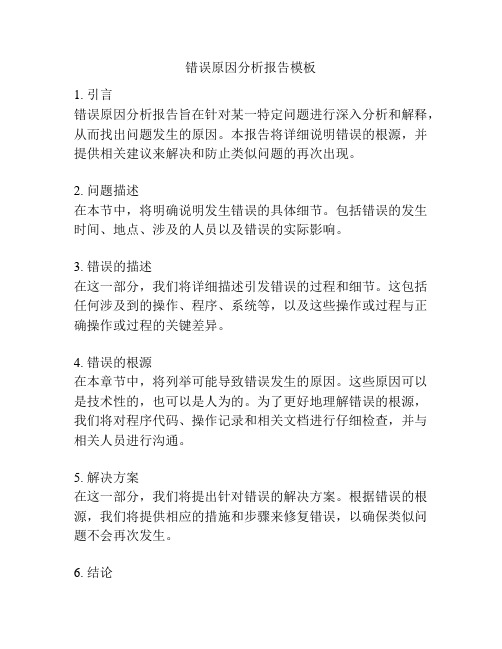
错误原因分析报告模板
1. 引言
错误原因分析报告旨在针对某一特定问题进行深入分析和解释,从而找出问题发生的原因。
本报告将详细说明错误的根源,并提供相关建议来解决和防止类似问题的再次出现。
2. 问题描述
在本节中,将明确说明发生错误的具体细节。
包括错误的发生时间、地点、涉及的人员以及错误的实际影响。
3. 错误的描述
在这一部分,我们将详细描述引发错误的过程和细节。
这包括任何涉及到的操作、程序、系统等,以及这些操作或过程与正确操作或过程的关键差异。
4. 错误的根源
在本章节中,将列举可能导致错误发生的原因。
这些原因可以是技术性的,也可以是人为的。
为了更好地理解错误的根源,我们将对程序代码、操作记录和相关文档进行仔细检查,并与相关人员进行沟通。
5. 解决方案
在这一部分,我们将提出针对错误的解决方案。
根据错误的根源,我们将提供相应的措施和步骤来修复错误,以确保类似问题不会再次发生。
6. 结论
本报告的结论将总结错误的根源、解决方案的有效性以及可预见的进一步步骤。
此外,还应强调在解决错误过程中学到的教训,并提供额外的建议以防止类似错误再次发生。
7. 参考文献
在这一部分,将罗列本报告所引用的相关资料和参考文献。
这些资料可以是技术手册、研究报告或专家意见等。
错误原因分析报告范文(精选)(二)

错误原因分析报告范文(精选)(二)引言概述:错误原因分析报告是对某一错误发生的原因进行剖析并提供解决方案的重要文档。
本报告旨在对错误原因进行深入分析,以便各相关部门和人员能够从错误中吸取教训,并采取适当的措施预防其再次发生。
本文将从多个维度对错误原因进行分析,以期为读者提供宝贵的参考和借鉴。
正文:一、人为因素1. 缺乏专业知识:错误的原因之一是员工缺乏专业知识,无法正确识别和解决问题。
这可能导致错误的决策和操作,从而产生一系列问题。
2. 不规范的工作流程:部分员工可能没有严格遵循规定的工作流程,导致错漏操作。
这种无序的工作方式容易产生错误,特别是在带有高风险的任务中。
3. 马虎态度:一些员工工作时缺乏细致认真的态度,对任务的完成不够负责,这种马虎态度可能是错误发生的根本原因之一。
二、技术因素1. 设备故障:技术因素中最常见的是设备故障。
如果设备没有经过及时的维护和检修,其正常运行的可靠性将大大降低,从而导致错误的发生。
2. 系统漏洞:系统中的漏洞和软件错误可能导致错误的发生。
这些问题可能来自于开发过程中的疏忽,也可能是系统设计的缺陷或者未被发现的安全漏洞。
3. 数据丢失:数据丢失是技术因素中常见的错误。
这可能是由于错误的备份策略、硬件故障或人为操作失误等各种原因导致。
三、组织因素1. 弱化反馈机制:组织中如果反馈机制不健全,员工将无法及时发现自己的错误。
没有正确的反馈和纠正机制将导致错误的持续存在。
2. 没有明确的责任分工:如果在组织中没有明确的责任分工,员工可能会产生任务重复或遗漏的问题,从而导致错误的发生。
3. 激励机制不当:不合理的激励机制可能导致员工为了达到个人利益而忽略了错误的风险。
缺乏正确的激励机制会削弱员工对错误的敏感度和警觉性。
四、沟通问题1. 信息不畅通:如果在组织内部或者团队之间的沟通不畅通,信息传递有误或滞后,员工可能会在处理问题时基于错误或不完整的信息,导致错误的发生。
2. 缺乏协作:团队成员之间缺乏良好的协作和配合,可能导致信息传递不及时,任务分工不清晰,进而产生一系列错误。
工作错误分析报告怎么写

工作错误分析报告怎么写引言工作错误分析报告是一种用于记录和分析工作中出现的错误、问题或失误的重要文档。
通过详细描述错误情况、分析原因以及提出解决方案,可以帮助团队更好地应对类似问题,并提高工作效率。
本文将介绍如何编写一份高质量的工作错误分析报告。
报告结构一份完整的工作错误分析报告应该包含以下几个主要部分:1.问题描述首先,需要明确描述出现的错误或问题。
将问题具体化,包括错误的时间、位置、影响范围等。
例如:在2021年10月15日上午9点至11点期间,我们在开展新产品推广活动时遇到了一个关键问题:部分用户在支付过程中遭遇无法支付的错误。
2.问题分析在这一部分,需要对问题进行分析,找出问题的原因。
可以考虑以下几个方面进行分析:•流程分析:对相关流程的各个环节进行仔细梳理,找出可能存在的问题节点;•数据分析:通过对相关数据的观察和统计分析,找出异常数据或数据趋势,以帮助找出问题;•技术分析:对涉及的技术、系统或软件进行分析,寻找可能的技术原因;•人员分析:对参与工作的人员进行访谈或调查,了解他们的操作流程,找出可能存在的问题。
3.问题影响评估在这一部分,需要评估问题带来的影响,包括时间成本、财务成本、用户满意度、公司声誉等方面。
例如:这个支付错误导致了用户无法成功完成支付,进而影响了用户对我们产品的体验和信任度,对公司形象造成了一定的负面影响。
4.问题解决方案在这一部分,需要提出解决问题的具体方案,并对每个方案进行评估。
可以从以下几个方面考虑:•技术方案:通过技术手段解决问题;•流程优化:通过优化工作流程、规范操作流程等改进措施解决问题;•人员培训:通过对相关人员进行培训,提高其操作技能。
5.解决方案实施在这一部分,需要明确解决方案的具体实施步骤和时间安排。
例如:我们将采取以下措施来解决支付错误问题:1. 技术团队将对支付系统进行全面审查,并修复相关漏洞;2. 品质团队将加强对支付流程的监控和测试,确保问题不再出现;3. 培训部门将组织必要的培训课程,提高员工对支付系统的操作熟练度。
工作错误分析报告
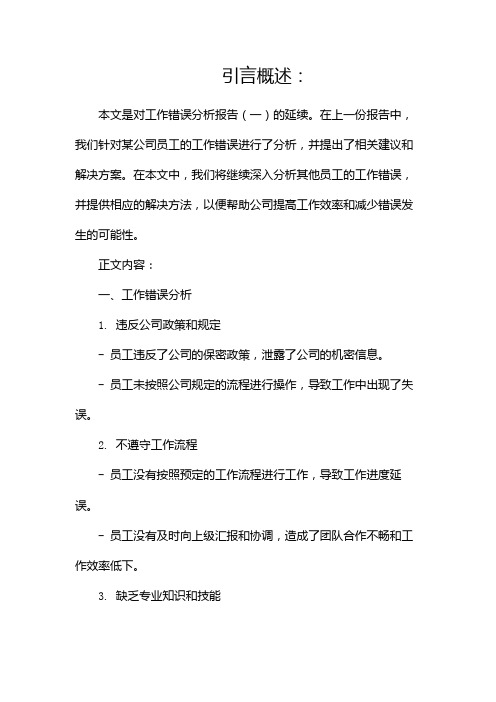
引言概述:本文是对工作错误分析报告(一)的延续。
在上一份报告中,我们针对某公司员工的工作错误进行了分析,并提出了相关建议和解决方案。
在本文中,我们将继续深入分析其他员工的工作错误,并提供相应的解决方法,以便帮助公司提高工作效率和减少错误发生的可能性。
正文内容:一、工作错误分析1. 违反公司政策和规定- 员工违反了公司的保密政策,泄露了公司的机密信息。
- 员工未按照公司规定的流程进行操作,导致工作中出现了失误。
2. 不遵守工作流程- 员工没有按照预定的工作流程进行工作,导致工作进度延误。
- 员工没有及时向上级汇报和协调,造成了团队合作不畅和工作效率低下。
3. 缺乏专业知识和技能- 员工在某一领域的专业知识不足,导致在相关工作中容易出现错误。
- 员工的技能水平不够高,无法熟练地使用所需的工具和软件,从而导致工作中频繁出现错误。
4. 压力和情绪管理不当- 员工经常在工作中感到压力和焦虑,导致注意力不集中,容易出现错误。
- 员工对工作中的挫折和错误反应过度,情绪不稳定,影响了自己和团队的工作效率。
5. 队伍管理不善- 上级管理人员没有明确的工作目标和任务分配,导致员工无所适从和工作错乱。
- 缺乏有效的团队沟通和合作,造成工作任务无法顺利完成和错误频发。
二、解决方法1. 加强公司政策和规定的宣导和培训- 向员工清晰地介绍公司的各项政策和规定,并建立必要的宣导机制。
- 为员工提供相关的培训和指导,确保他们理解和遵守公司的政策和规定。
2. 建立明确的工作流程和监督机制- 设定清晰的工作流程,确保员工按照规定的步骤进行工作。
- 设立有效的监督机制,及时发现和纠正工作中的错误和问题。
3. 提供专业知识和技能培训- 为员工提供必要的专业知识和技能培训,提高他们在相关领域的专业素养。
- 鼓励员工主动学习和提升自己的技能水平,提供相应的学习机会和资源支持。
4. 建立良好的压力和情绪管理机制- 通过心理健康教育和咨询,帮助员工有效管理工作中的压力和情绪。
错误原因分析报告范文(必备(二)2024

错误原因分析报告范文(必备(二)引言概述:错误原因分析报告是对发生错误的原因进行深入分析和总结,以便找出解决问题的有效方法。
本文将为您提供一个错误原因分析报告的范文,帮助您了解如何撰写这样的报告。
正文:一、背景和问题描述1. 问题描述:明确描述发生的错误以及错误所带来的影响;2. 问题重要性:说明为什么需要对该错误进行分析,并解释该错误对业务或项目的影响;3. 背景介绍:提供相关的背景信息,为读者提供更好的理解该错误情境。
二、错误原因分析1. 数据问题a. 数据完整性:分析数据缺失或错误导致错误的根本原因;b. 数据质量:分析数据质量差异导致错误的具体原因;c. 数据规范:分析数据规范不符合导致错误的具体细节。
2. 流程问题a. 流程设计:分析流程设计的不当导致错误的产生;b. 流程实施:分析流程实施中存在的问题及其根本原因;c. 流程控制:分析流程控制的不恰当导致错误的发生。
3. 技术问题a. 系统架构:分析系统架构设计问题导致错误的产生;b. 技术配置:分析技术配置不当导致错误的具体原因;c. 编码实现:分析编码实现不规范导致错误的具体细节。
4. 人员问题a. 培训不足:分析人员培训不足引发错误的具体原因;b. 缺乏经验:分析人员缺乏经验导致错误的具体细节;c. 沟通不畅:分析沟通不畅导致错误的发生。
5. 管理问题a. 资源分配:分析资源分配不当导致错误的发生;b. 监督管理:分析监督管理不到位导致错误的具体细节;c. 岗位职责:分析岗位职责不明确引发错误的具体原因。
总结:通过对错误原因的深入分析,我们得出了以下结论:1. 数据问题是导致该错误的主要原因,其中数据完整性和数据质量是需要重点关注的方面;2. 流程问题和技术问题也是导致错误的重要因素,需要优化流程设计和技术配置;3. 人员问题和管理问题也对错误的发生产生了一定的影响,需要加强人员培训和管理监督;4. 在解决该错误时,重点应关注数据的完整性和质量,同时优化流程设计和技术配置,加强人员培训和管理监督。
错误行为分析报告

错误行为分析报告引言错误行为是指在工作、学习或日常生活中产生的不当行为或错误操作。
对错误行为进行分析和评估可以帮助我们识别问题的根本原因,从而采取相应的措施来预防和纠正这些错误行为。
本报告旨在分析错误行为的常见原因,并提出相应的解决方案。
错误行为的类型在分析错误行为之前,首先了解不同类型的错误行为是非常重要的。
以下是常见的错误行为类型:1.粗心大意:这种错误行为通常是由于注意力不集中或过度自信而导致的。
这种类型的错误包括忽略重要细节、遗漏步骤、误拿错件等。
2.不负责任:不负责任的行为包括拖延工作、推卸责任、不遵守规定等。
这种行为可能导致工作的延误、质量问题和与他人的冲突。
3.缺乏沟通:缺乏沟通的行为是指无法有效地与他人沟通、表达自己的意见和需求,也无法理解他人的意图和要求。
这种行为会导致信息传递不畅、项目进度延误和合作不顺利。
4.冲动行为:冲动行为是指在情绪高涨或压力下做出的仓促、不理智的决策。
这种行为可能导致错误的判断、不明智的决策和后悔。
错误行为的原因分析针对不同类型的错误行为,我们需要深入分析其原因,以制定相应的解决方案。
粗心大意粗心大意的原因通常包括以下几个方面:1.注意力不集中:在执行任务时,如果我们的思维被其他事物分散,就会容易犯错。
比如在接电话的时候同时进行其他任务,就容易忽略细节。
2.缺乏技能或知识:如果我们缺乏必要的技能或知识,就很容易犯错误。
比如,一个新员工可能由于缺乏培训而在工作中犯错。
3.过度自信:有时候,我们可能因为过度自信而忽视一些重要的细节。
这种情况下,我们对自己的能力产生了错误的评估,导致了错误的行为。
不负责任的原因可以分为以下几个方面:1.缺乏动机或目标:如果一个人对自己的工作没有明确的目标或者缺乏动力,就可能表现出不负责任的行为。
缺乏动机使得人们不愿意承担责任或完成任务。
2.不合理的工作安排:有时候,不合理的工作安排也会导致人们表现出不负责任的行为。
比如,给一个人过多的任务或者缺乏适当的资源支持,都可能让人们觉得无法胜任工作,从而表现出不负责任的行为。
- 1、下载文档前请自行甄别文档内容的完整性,平台不提供额外的编辑、内容补充、找答案等附加服务。
- 2、"仅部分预览"的文档,不可在线预览部分如存在完整性等问题,可反馈申请退款(可完整预览的文档不适用该条件!)。
- 3、如文档侵犯您的权益,请联系客服反馈,我们会尽快为您处理(人工客服工作时间:9:00-18:30)。
错误分析理论(error analysis)作为应用语言 学的一个分支,产生于二十世纪六十年代末、七十 年代初。二十世纪五十年代末,C· Frices和R· Lado 等一些美国语言学家和语言教学家提出了对比分析 理论(contrastive analysis)。他们认为:通过对学 习者的母语(mother tongue)和目的语(target language)对比研究,可以预见学习者在 学习 该目的语中可能会犯的错误,但是局限性也逐渐的 暴露了出来。为了对学习者的错误进行系统性的分 析研究,以确定其错误的来源,为教学过程中消除 这些错误提供依据,一种分析语言错误的新理论 “错误分析理论”产生了。
Correction of errors in the classroom
• What errors to correct?
3 criteria: 1. Errors that affect communication should be corrected. 2. A grossly ungrammatical sentence should be corrected. 3. Errors in the structure or rule that is being taught should be corrected.
Basic assumptions
Errors in L2 learning are unavoidable.
Errors made by L2 learners can be observed, analyzed, classified and described.
3 steps to identify errors---a model provided by Corder
mistakes or errors?
errors of performance语言行为错误
(performance errors)由于紧张,粗 心,激动等等所犯的错误。
errors of competence语言能力错误
(competence errors)还未掌握所学的 语言的体系和规律而出现了系统上的错误, 一般有老师纠正
step 3 step 2 step 1
Providing pairs of illformed or inappropriate sentences and reconstructed wellformed sentences in the target language for comparison
products of chance circumstances, such as slips of the tongue or of the pen.
errors that reveal learners' underlying knowledge of the target language.
Only errors of competence are worth studying and analyzing, because they are systematic. But errors of competence can only be inferred from errors of performance.
Transfer of training
1.语际语言错误(interlingual errors)
把本族语的语言和文化习惯带到了目的语的学习和运用中所造成的
(1)在词汇方面:the public medical fare (正确的 说法: the free medical fare ) to the Interlingual transfer refers (interference 2)在语法方面: I very much miss yousuch (正确的 of the first language, as 说法: the mechanical application of rules, set I miss you very much) or items of the L1 to L2 context. It (phrases 3)在文化方面:由于语言学习者对目的语的文化 explains many errors made at the beginning 风俗习惯不懂或者了解的较少,在使用目的语时套 stage of L2 learning. 用母语的文化习惯就会产生语言错误。如中国人见 面打招呼常用的“Have you had your dinner?”对 西方国家的人来说就完全不适用。
Communication strategies is the conscious employment of a verbal or nonverbal mechanism for communicating an idea when precise linguistic forms are for some reason not readily available to the learner at a point in communication. Four main communication strategies are generally used by L2 learners: 1. avoidence 2. prefabricated petterns 3. appeal to authority 4. language switch
Description
stages in which errors are made
general nature of errors
levels of language
stages in which errors are made general nature of errors
1. Presystematic stage 2. Systematic stage 3. Postsystematic stage
Providing
interpretations and constructing well-
Identifying overt and
covert errors
formed sentences in
the target language
Description of errors
Comparison
Explanation of errors---why are errors made
Interlingual transfer Cognitive and affective factors
Explanation of errors
Intralingual transfer
Communication strategies
Difference from CA
CA: examine errors resulting from the interference of the first language; EA: examine errors attributable to all possible sources.
EA can easily supersede CA suːpə‘siːd 取代
例如:由于过度概括work,play,want等动词 变成过去式是直接在词尾加ed形式,学生就将动 词go,do,buy等写成了gaining refers to those errors caused by the way in which the language items have been presented or practiced, either in the classroom or in the textbook.
The definition of errors
Dulay et al: error refers to any deviation diːvɪ‘eɪʃ(ə)n 误 差 , 偏 离 f r o m a selected norm of language performance, no matter what the characteristics or causes of the deviation might be.
Two issues are worth noting
Fossilization
1. 2. 3. 4.
addition 添加 omission 省略 substitution ordering 错误词序
levels of language
phonology [fə‘nɒlədʒɪ]音系学, orthography [ɔː'θɒgrəfɪ]写作体系, lexicon, grammar, discourse
Brown: Error analysis is based on the following assumptions
Human learning involves making errors. Errors made by L2 learners help understanding the process of L2 learning.
2语内语言错误(intralingual errors)
Intralingual transfer refers to overgeneralization of rules of the target language. Intralingual transfer occurs when the learner has learned some rules of the target language but has not learned the restrictions of their application. 人类学习语言的过程一般是对接触到的语言材料 进行不断的概括,进而得出规则的过程。
